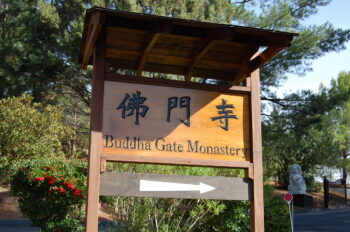 Welcome to Buddha Gate Monastery! Buddha Gate Monastery is the first overseas branch of Chung Tai Chan Monastery in Taiwan. Buddha Gate was established in 2000 by Grand Master Wei Chueh. It is located on 17 acres in Lafayette, California.
Welcome to Buddha Gate Monastery! Buddha Gate Monastery is the first overseas branch of Chung Tai Chan Monastery in Taiwan. Buddha Gate was established in 2000 by Grand Master Wei Chueh. It is located on 17 acres in Lafayette, California.
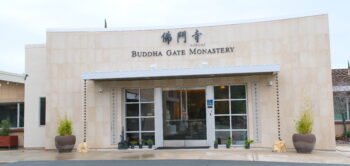
Begin your visit at the Reception Hall. Here, you can make a candle offering to the Buddha, sign up for classes and events, or write a blessing or memorial tablet for yourself and your loved ones.
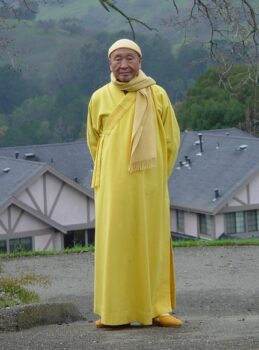
In the Reception Hall, you’ll find a picture of Grand Master Wei Chueh, the founding abbot of Chung Tai Chan Monastery. Born in Sichuan Province, he was ordained in 1963 and spent over a decade in secluded practice before emerging to teach the Dharma. He founded Lingquan Monastery in 1987 and later established Chung Tai Chan Monastery in 2001 to accommodate a growing community, creating meditation centers in Taiwan and abroad. A passionate educator, he founded the Chung Tai Buddhist Institute for Dharma teachers and Pu Tai Schools (K-12) to instill Buddhist values in children. His legacy includes teaching, large-scale Dharma ceremonies, and the Chung Tai World Museum. Click here to learn more.
Upper Lot
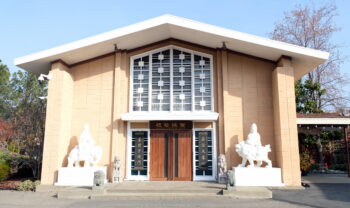 We hold our weekly Chan Buddhism classes in the Lecture Hall. The classes offer a comprehensive journey through meditation and Buddhist teachings, with each session divided into two parts: one hour of meditation practice (including instruction) and one hour of lecture on Buddhist principles. To learn more, ask our volunteers at the Reception Hall.
We hold our weekly Chan Buddhism classes in the Lecture Hall. The classes offer a comprehensive journey through meditation and Buddhist teachings, with each session divided into two parts: one hour of meditation practice (including instruction) and one hour of lecture on Buddhist principles. To learn more, ask our volunteers at the Reception Hall.
As you face the Lecture Hall, you will see:
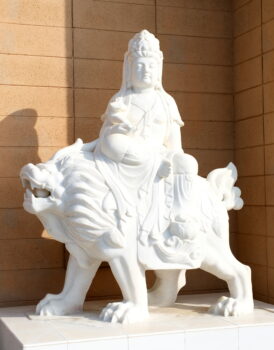 Manjusri Bodhisattva (right statue), often depicted in white marble, symbolizes wisdom and mental purity. As the Bodhisattva of Wisdom, Manjusri is shown riding a roaring lion, which represents the power of the Dharma’s voice and the bold, vigorous practice of a Bodhisattva. The lion’s roar symbolizes the ability to awaken beings from ignorance, inspiring them to pursue the path of enlightenment.
Manjusri Bodhisattva (right statue), often depicted in white marble, symbolizes wisdom and mental purity. As the Bodhisattva of Wisdom, Manjusri is shown riding a roaring lion, which represents the power of the Dharma’s voice and the bold, vigorous practice of a Bodhisattva. The lion’s roar symbolizes the ability to awaken beings from ignorance, inspiring them to pursue the path of enlightenment.
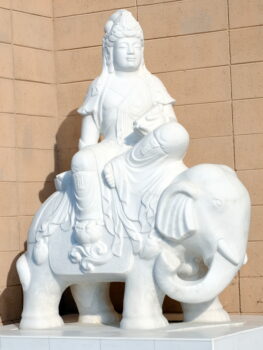 Samantabhadra Bodhisattva (left statue) embodies the principle of practice, earning the title “Bodhisattva of Great Practice.” He is often depicted riding a six-tusked white elephant, symbolizing the six paramitas: generosity, morality, patience, diligence, meditation, and prajna (wisdom). The six tusks represent the Bodhisattva’s mastery of these perfections, which are essential for spiritual progress. Alongside Manjusri and Shakyamuni Buddha, Samantabhadra forms the Shakyamuni Triad in Mahayana Buddhism, representing wisdom, practice, and teaching in perfect harmony.
Samantabhadra Bodhisattva (left statue) embodies the principle of practice, earning the title “Bodhisattva of Great Practice.” He is often depicted riding a six-tusked white elephant, symbolizing the six paramitas: generosity, morality, patience, diligence, meditation, and prajna (wisdom). The six tusks represent the Bodhisattva’s mastery of these perfections, which are essential for spiritual progress. Alongside Manjusri and Shakyamuni Buddha, Samantabhadra forms the Shakyamuni Triad in Mahayana Buddhism, representing wisdom, practice, and teaching in perfect harmony.
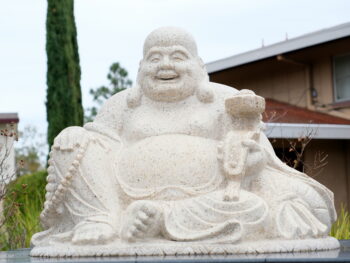
Maitreya Bodhisattva (greeting visitors by the gate) is revered as the Buddha of the Future. Though he has achieved enlightenment, Maitreya has chosen to delay his Buddhahood to assist sentient beings, embodying selfless compassion. His name translates to “benevolence” or “friendship,” reflecting his mission to inspire kindness, joy, and hope in those who follow the path of awakening.
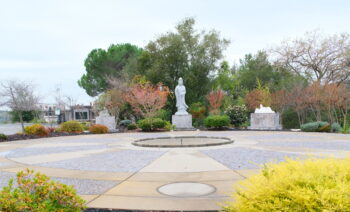 Behind you is the Wishing Pond. The six circles around the pond represent the six paramitas, or perfections, of a Bodhisattva: giving, tolerance, diligence, meditation, moral conduct, and prajna (wisdom). The noble Eightfold Path is symbolized by triangular marks in the circle and is grouped into three categories:
Behind you is the Wishing Pond. The six circles around the pond represent the six paramitas, or perfections, of a Bodhisattva: giving, tolerance, diligence, meditation, moral conduct, and prajna (wisdom). The noble Eightfold Path is symbolized by triangular marks in the circle and is grouped into three categories:
- Blessings: Right Speech, Right Action, Right Livelihood
- Meditation: Right Effort, Right Mindfulness, Right Samadhi (a deeply concentrated state of mind)
- Wisdom: Right Understanding, Right Thought.
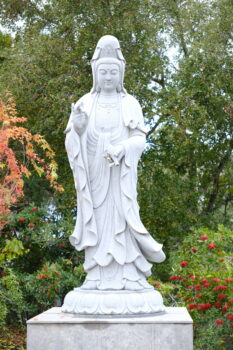 You will find several statues of the Guan Yin Bodhisattva scattered throughout, including the large one overlooking the wishing pond. The name Guan Yin means “The One Who Hears the Cries of the World,” reflecting the Bodhisattva’s compassionate ability to listen to calls for help and respond to the needs of all beings. It is said that Guan Yin can take any form — male or female — to assist.
You will find several statues of the Guan Yin Bodhisattva scattered throughout, including the large one overlooking the wishing pond. The name Guan Yin means “The One Who Hears the Cries of the World,” reflecting the Bodhisattva’s compassionate ability to listen to calls for help and respond to the needs of all beings. It is said that Guan Yin can take any form — male or female — to assist.
Visitors can approach the Guan Yin statue to make sincere vows and pray for blessings. Guan Yin is believed to compassionately protect those who come with respect and devotion. By reflecting inward and listening deeply, we align ourselves with Guan Yin’s profound teaching: “Contemplating self-nature through hearing and attaining supreme enlightenment.”
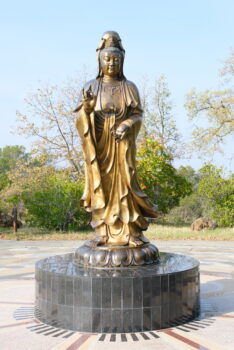 Follow the meditation path up to the Hill Top for a beautiful view of the Bay Area. At the summit, you will find another large bronze Guan Yin Bodhisattva statue. Like the statue by the pond, she rests on a lotus platform that symbolizes purity and gazes compassionately upon all sentient beings. A small Amitabha Buddha adorns Guan Yin’s crown, signifying her role in upholding the Buddha’s teachings. She holds a vase of pure water, representing the universal spread of the Dharma, likened to sweet dew that cleanses and purifies the body and mind.
Follow the meditation path up to the Hill Top for a beautiful view of the Bay Area. At the summit, you will find another large bronze Guan Yin Bodhisattva statue. Like the statue by the pond, she rests on a lotus platform that symbolizes purity and gazes compassionately upon all sentient beings. A small Amitabha Buddha adorns Guan Yin’s crown, signifying her role in upholding the Buddha’s teachings. She holds a vase of pure water, representing the universal spread of the Dharma, likened to sweet dew that cleanses and purifies the body and mind.
Lower Lot
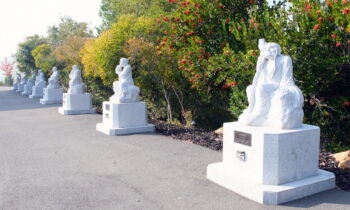 The area surrounding our Meditation Hall features eighteen statues of the Buddha’s original followers who attained enlightenment, known as Arhats. Arhats have fully realized the Buddhist Doctrine. Their minds are free from greed, anger, and ignorance. They have deeply understood the Four Noble Truths, followed the Noble Eightfold Path, realized the emptiness of the false ego, and extinguished the poisons of greed, anger, and ignorance, thereby transcending the cycle of rebirth. In some texts, the Buddha is described as being accompanied by 500 Arhats.
The area surrounding our Meditation Hall features eighteen statues of the Buddha’s original followers who attained enlightenment, known as Arhats. Arhats have fully realized the Buddhist Doctrine. Their minds are free from greed, anger, and ignorance. They have deeply understood the Four Noble Truths, followed the Noble Eightfold Path, realized the emptiness of the false ego, and extinguished the poisons of greed, anger, and ignorance, thereby transcending the cycle of rebirth. In some texts, the Buddha is described as being accompanied by 500 Arhats.
 The Chan Hall is where we hold Buddhist ceremonies, practice meditation, and chanting. The hall’s minimalist design embodies the concept of letting go, encouraging inward reflection, and fostering the realization of emptiness, ultimately guiding practitioners toward enlightenment.
The Chan Hall is where we hold Buddhist ceremonies, practice meditation, and chanting. The hall’s minimalist design embodies the concept of letting go, encouraging inward reflection, and fostering the realization of emptiness, ultimately guiding practitioners toward enlightenment.
 Upon entering Chan Hall, look up to see the large lotus on the ceiling. In Buddhism, the lotus flower symbolizes purity, spiritual awakening, and enlightenment. Its growth from muddy waters to a beautiful bloom represents the journey from ignorance to enlightenment, showing that resilience and beauty can arise from difficult circumstances. It also signifies purity of body, speech, and mind, as the flower remains unstained by the mud it grows in.
Upon entering Chan Hall, look up to see the large lotus on the ceiling. In Buddhism, the lotus flower symbolizes purity, spiritual awakening, and enlightenment. Its growth from muddy waters to a beautiful bloom represents the journey from ignorance to enlightenment, showing that resilience and beauty can arise from difficult circumstances. It also signifies purity of body, speech, and mind, as the flower remains unstained by the mud it grows in.
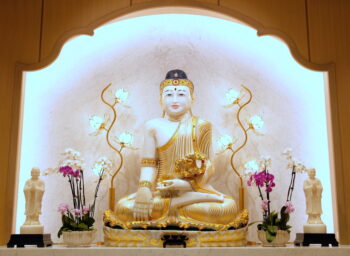 Shakyamuni Buddha (center statue) attained ultimate enlightenment and is revered as the fundamental teacher and the founder of Buddhism. Born as Prince Siddhartha Gautama in ancient India, he was raised in the luxury of a royal palace, shielded from the hardships of life. However, after witnessing the realities of aging, illness, and death, he renounced his privileged life to seek a solution to human suffering. Through years of ascetic practices and profound meditation under the Bodhi tree, he achieved enlightenment, discovering the Four Noble Truths and the Eightfold Path as the way to liberation. His teachings have since inspired countless beings on the path to enlightenment, breaking free from samsara—the endless cycle of birth, death, and rebirth.
Shakyamuni Buddha (center statue) attained ultimate enlightenment and is revered as the fundamental teacher and the founder of Buddhism. Born as Prince Siddhartha Gautama in ancient India, he was raised in the luxury of a royal palace, shielded from the hardships of life. However, after witnessing the realities of aging, illness, and death, he renounced his privileged life to seek a solution to human suffering. Through years of ascetic practices and profound meditation under the Bodhi tree, he achieved enlightenment, discovering the Four Noble Truths and the Eightfold Path as the way to liberation. His teachings have since inspired countless beings on the path to enlightenment, breaking free from samsara—the endless cycle of birth, death, and rebirth.
Ananda and Mahakashyapa were two of Shakyamuni Buddha’s foremost disciples. They flank the Buddha on the altar.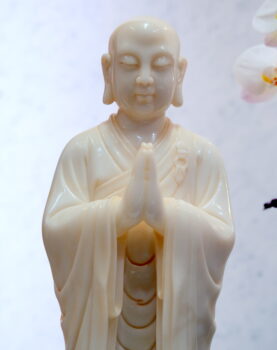
Ananda (viewer’s left) was renowned as the Buddha’s cousin and personal attendant. Known for his exceptional memory and devotion, he was instrumental in documenting the oral transmission of the Buddha’s teachings.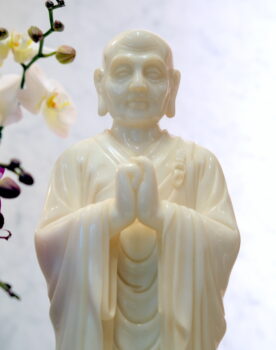 Mahakashyapa (viewer’s right) was known for his austere practice and deep meditative insight. He is often associated with leading the First Buddhist Council, where he ensured the preservation of the Buddha’s teachings, particularly through the story of the “Flower Sermon.”
Mahakashyapa (viewer’s right) was known for his austere practice and deep meditative insight. He is often associated with leading the First Buddhist Council, where he ensured the preservation of the Buddha’s teachings, particularly through the story of the “Flower Sermon.”
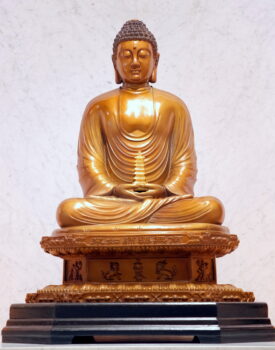 Medicine Buddha (right statue), also known as the Buddha of Healing, made twelve great vows to aid sentient beings in overcoming sickness, achieving spiritual health, and ultimately attaining enlightenment. His teachings and practices are often invoked for healing, protection, and the purification of negative karma, making him a symbol of both inner and outer well-being.
Medicine Buddha (right statue), also known as the Buddha of Healing, made twelve great vows to aid sentient beings in overcoming sickness, achieving spiritual health, and ultimately attaining enlightenment. His teachings and practices are often invoked for healing, protection, and the purification of negative karma, making him a symbol of both inner and outer well-being.
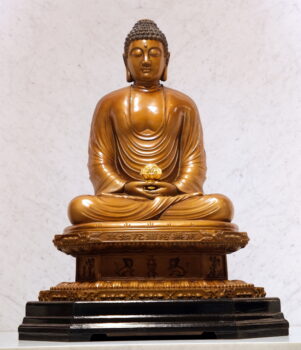 Amitabha Buddha (left) presides over the Pure Land, a realm of ultimate bliss and spiritual fulfillment. The greeting “Amitofo,” derived from his name, carries the meaning of Infinite Light and Infinite Life, serving as a reminder of his boundless compassion and wisdom.
Amitabha Buddha (left) presides over the Pure Land, a realm of ultimate bliss and spiritual fulfillment. The greeting “Amitofo,” derived from his name, carries the meaning of Infinite Light and Infinite Life, serving as a reminder of his boundless compassion and wisdom.
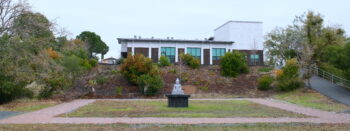 Behind the Chan Hall and downhill lies our Walking Meditation Path, used for walking meditation, a form of mindfulness practice where individuals focus on the act of walking, using it to cultivate awareness and presence in the moment while the body is in motion.
Behind the Chan Hall and downhill lies our Walking Meditation Path, used for walking meditation, a form of mindfulness practice where individuals focus on the act of walking, using it to cultivate awareness and presence in the moment while the body is in motion.
